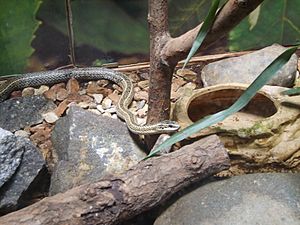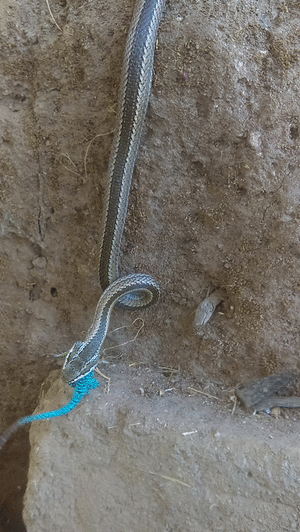Chilean green racer facts for kids
The Philodryas chamissonis, also known as the Chilean green racer or Chilean long-tailed snake, is a fascinating snake. It is a moderately venomous snake that belongs to the Colubridae family. This snake is endemic to Chile, which means it is found only in Chile and nowhere else in the world.
Quick facts for kids Philodryas chamissonis |
|
|---|---|
 |
|
| Conservation status | |
| Scientific classification | |
| Genus: |
Philodryas
|
| Species: |
chamissonis
|
| Synonyms | |
|
|
Contents
Where Does Its Name Come From?
The scientific name, chamissonis, honors a German botanist and poet named Adelbert von Chamisso.
Where Does This Snake Live?
The Chilean green racer is found across a large area in Chile. Its habitat stretches from Paposo in the north all the way down to Valdivia in the south.
What Does the Chilean Green Racer Look Like?
This snake is usually gray with black and white stripes running along its body. It is a medium-sized snake. It typically grows to about 1.4 meters (around 4.5 feet) in total length, which includes its tail. The tail itself makes up about 25% to 28.5% of its total body length.
What Kind of Places Does It Live In?
P. chamissonis can live in many different types of habitats. You can find it from sea level up to high altitudes of about 2,300 meters (around 7,500 feet).
What Does the Chilean Green Racer Eat?

The diet of the Chilean green racer mainly consists of small rodents, birds, amphibians, and other smaller reptiles. For example, it especially likes to hunt and eat lizards from the Liolaemus group.
How Does It Reproduce?
The Chilean green racer is an oviparous reptile. This means that the female snake lays eggs, and the young hatch from these eggs outside the mother's body.
Is Its Bite Dangerous?
Bites from the Chilean green racer are not very common because the snake is rarely encountered. However, if a bite does occur, it can be painful and cause a lot of swelling around the bite area.
See also
 In Spanish: Culebra de cola larga para niños
In Spanish: Culebra de cola larga para niños


